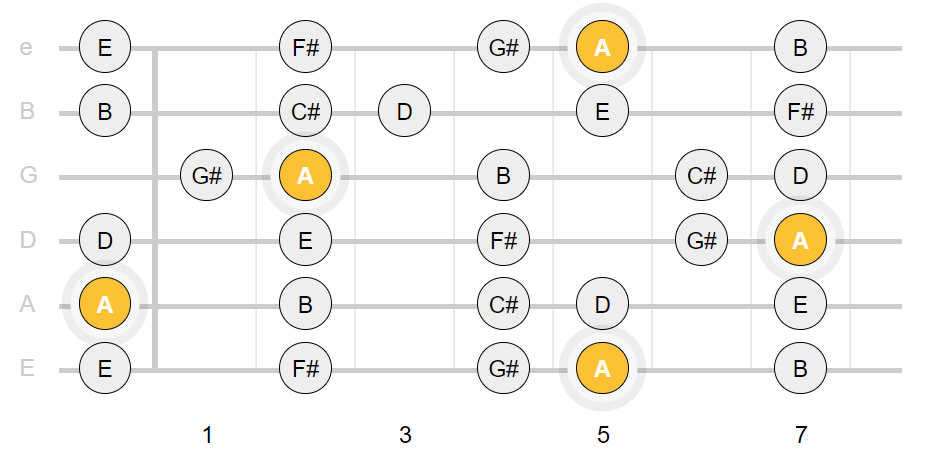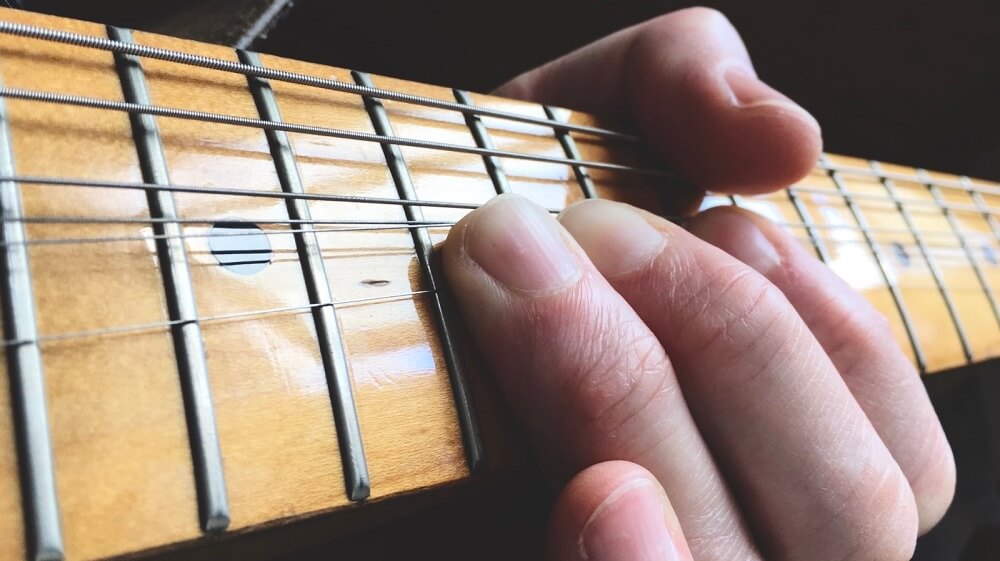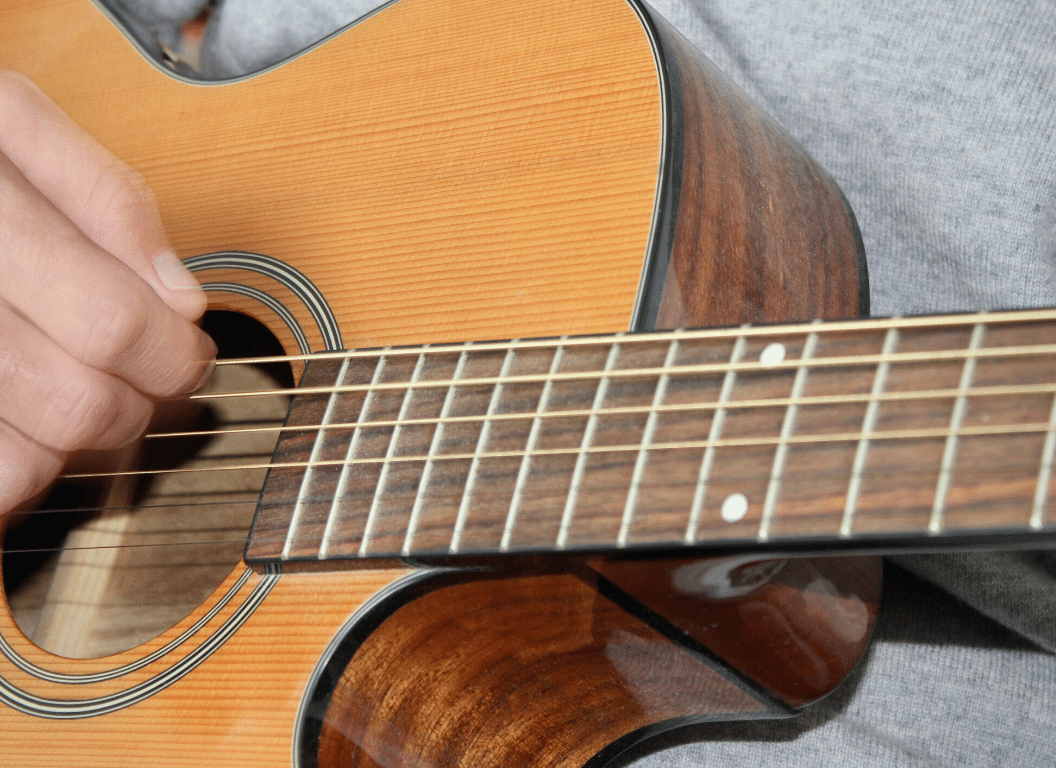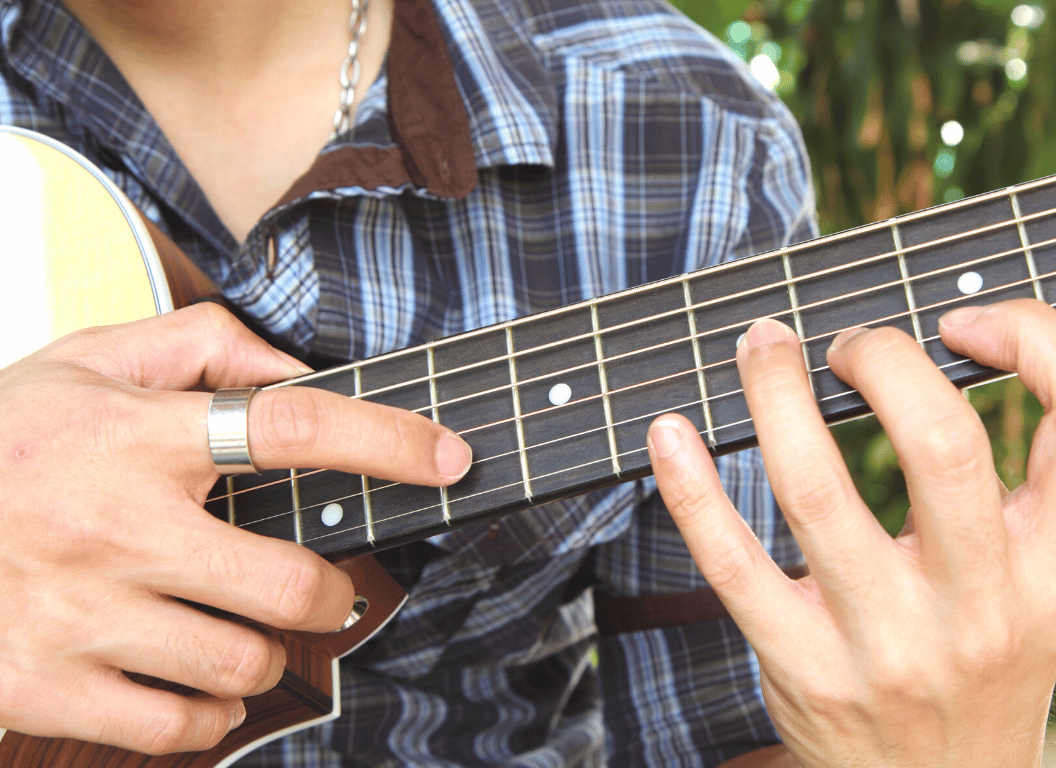Bending and vibrato are two techniques that every guitar player should master.
They both add color and expression to your playing, but they’re not always used in the same way.
By understanding the differences between vibrato and bending, you’ll be able to create more expressive guitar lines and solos and apply each technique more effectively in your playing
In this blog post, we’ll take a look at 10 of those differences and answer some of the most frequently asked questions on this topic.
Let’s get started!
Table of Contents
- What’s The Difference Between Vibrato And Bending?
- 1. Vibrato adds intensity but bending adds way more expression
- 2. Vibrato produces a wavering sound while bending creates a sharp change in pitch
- 3. Bendings are usually transitional while vibratos highlight certain notes
- 4. You can use vibrato on any string, but bending is mostly done on the higher strings
- 5. Bending requires more force on the string than vibrato
- What is a guitar bend?
- How to correctly do a guitar bend?
- What is a guitar vibrato?
- How to properly do a guitar vibrato?
What’s The Difference Between Vibrato And Bending?
The quick answer is that vibrato is used to produce a wavering or pulsing sound, while bending produces a sharp or intense change in pitch. Bending is also usually used to create sustained notes, while vibrato is typically used for shorter notes or phrases.
Sometimes beginner guitar players tend to get confused when they start to hear these two terms.
This is because these techniques are essentially very similar, but at the same time, sound and act very differently when played.
1. Vibrato adds intensity but bending adds way more expression
The first difference between the two is that vibrato adds a lot more intensity to a note while bending adds more expression.
In other words, when you hear a string bend, you’re essentially hearing the guitarist’s own input on how much force and speed it should have.
Now, when you hear guitar melodies or solos with a lot of vibratos, these tend to sound stronger and have a richer tone.
The sound produced by vibrato makes the note sound louder, more defined, and it adds extra warmth to the sound.
Does this mean that you can’t add expression with a vibrato?
Not necessarily, but when you compare the two, bending does it in a much better and clear way.
At the end of the day, though, a guitar player is the one that decides how much pressure and speed the vibrato has, so there’s some expression in there.
This YouTube video by Corey Congilio is a great resource that highlights this very well:
This video in specific is directly helping blues guitarists improve their vibrato techniques, and as we all know, blues is a very expressive genre.
Pay attention to when he’s playing the demo using mostly vibratos, and you’ll hear how much of an accent they make in the notes.
2. Vibrato produces a wavering sound while bending creates a sharp change in pitch
The second difference is that vibrato produces a wavering sound while bending creates a sharp change in pitch.
In essence, this is their most obvious difference and is what truly sets them apart from each other.
What this means is that when you do a vibrato, you’re essentially shaking the string back and forth fast, and that produces a sound that’s often characterized as being uncertain, strong, and louder.
Meanwhile, when you bend a string, you’re changing the tension on the string, which creates a strong and much faster change in the pitch of the note that’s being played.
Let’s say for example that we do a bend in the 5th fret, 1st string of our guitar.
That would be an A note, and if this bend is a whole step bend, we would now be hearing the note that’s two frets away from what we originally started on, which would be a B note.

The same thing happens with any other string or notes that we bend, and that’s why it’s a “sharp” change in pitch because you’re completely changing the note that’s being played.
On the other hand, a vibrato goes outside of a certain pitch, but usually not too far that is a completely new note, at most, it’s simply a half step away.
3. Bendings are usually transitional while vibratos highlight certain notes
This basically means that vibratos are often used to emphasize certain notes but bendings are utilized as a way of introducing and transitioning the listener to another note.
For example, let’s take a look at this guitar cover of all the solos in November Rain by Guns N’ Roses:
Slash’s solos in this song and the close-up playing perspective in this video are excellent ways to demonstrate this point.
You can hear and see that the bendings and vibratos are playing a huge role and that without them, it would be a totally different feeling getting transmitted.
These two techniques, bending and vibrato, are also generally done on sustained notes, which are notes that are held for an extended period of time.
When you play any note on your guitar, you can make it sound more interesting if you use vibrato, hence, you’re “highlighting” the note that’s being sustained.
As for bending, just like we mentioned before, you’re starting on one note and ending up on another one, usually a half step or a whole step away.
So in theory, you’re just introducing or “transitioning” into the soon-to-be sustained note.
4. You can use vibrato on any string, but bending is mostly done on the higher strings
This is usually more of a personal preference of the guitar player and how you were thought to do string bends and vibratos in the first place.
Higher strings, meaning the 1st, 2nd, and 3rd strings of your guitar are lighter and easier to bend than any of the other strings because of their gauge.
For this reason alone, is better to use them for bending, but on top of that, they give you more fretboard space to stretch the string as opposed to any of the lower strings (4th, 5th, and 6th strings).

Of course, you can still bend the lower strings, but in that case, instead of bending them upwards, you would have to do the bend in a downward direction.
In other words, when you’re bending the low three strings (E, A, D) you should bend down towards the floor, while the high three strings (G, B, E) should bend upwards towards the ceiling.
Now, on the other side of the spectrum, you can use vibrato pretty much on any string since this requires less force and fretboard space.
5. Bending requires more force on the string than vibrato
The amount of force you need to use for bending is typically greater than the amount of force you need for vibrato.
This is because when you bend a string, yes you’re changing its tension and pitch, but most importantly you have to make sure that the new note in which you land is the right one.
In other words, if you don’t bend the string enough or bend it too much, then you will most likely end up out of key and sounding awful to anyone who’s listening.
You can also say that bending not only requires more force than vibrato but also needs the exact amount of it.
When it comes to vibrato, you still need to put bend the string slightly to change its pitch, but this won’t necessarily require much force because you’re not entirely changing the note.
In other words, you’re just shaking the string back and forth to produce that wavering vibrato sound that we all know.
What is a guitar bend?
A guitar bend is a technique used to change the pitch of a note by using the fretting hand to push the string up or down while the string is still vibrating.
To execute a bend, the player simply places their finger behind the desired fret and uses their other hand to pluck or strum the string.
As mentioned before, when you’re bending the low three strings (E, A, D) you should bend down towards the floor, while the high three strings (G, B, E) should bend upwards towards the ceiling.
This is done so that you can use as much fretboard space as possible and that you’re able to correctly bend both a half and a whole step away from the current note.
A “half step” bend involves bending the string up or down one fret, while a “whole step” bend entails bending the string up or down two frets.
With practice, bends can be executed with a great deal of precision, allowing for very specific changes in pitch.
There are also “release bends” and “vibrato bends”, which are achieved by releasing the bend before it is fully executed or adding vibrato to the bent note respectively.
Here’s a great YouTube resource by Your Guitar Academy in which he shows how to play full, half, and quarter bends on your guitar:
One important thing to keep in mind when bending strings is that the higher the string is fretted, the more tension there is on it.
This means that you will need to use more force to bend a string that is fretted higher up on the fretboard.
Additionally, it is important to make sure that the string is properly in tune before you attempt to bend it, as this can help prevent the string from breaking, and ensures you’re sounding good.
When executed correctly, guitar bends can add a lot of expression and feeling to your playing.
How to correctly do a guitar bend?
One of the most essential skills for any guitar player is learning how to do a bend.
This can be done either with your fretting hand or your picking hand, depending on the type of bend you want to achieve.
One of the main keys is to practice slowly at first until you get a feel for the motion.
I encourage you to watch this YouTube video by Marty Music in which he goes over how to bend the right way on guitar:
One of the most difficult things when bending a guitar string is keeping it in tune, this is especially true when playing fast.
A quick tip that he shares in this video is how you should play the natural note before going back and attempting to bend into it.
This will rapidly register it in your head and allow your intuition to bend until you hear the same pitch again.
With practice, you will hopefully develop muscle memory and do this correctly every time.
Here are some bonus tips to help you bend a guitar string:
- 1. Make sure you are using the correct hand position for the string you are bending.
- 2. Ideally, your wrist should be the one rotating and causing the bend through your fingers.
- 3. Practice bending the string slowly at first, and train your ear to hear the correct pitch.
- 4. After you have bent the string, release the pressure slowly so that the string can return to its original tuning.
What is a guitar vibrato?
The vibrato guitar technique is a musical effect achieved by moving the hand up and down the string of a guitar, causing it to create a trembling sound.
The player presses down on the string, then rocks their finger back and forth.
This effect can be used to add interest to a single note or to give a whole phrase a more emotional quality.
Vibrato can also be achieved by using a variety of techniques, including the use of the tremolo arm or whammy bar, also known as artificial vibrato.
Players can also experiment with different amounts of pressure, speed, and depth to create different sounds.
On the other hand, vibratos can be created by either holding the string down and plucking it afterward or by using a finger to slightly bend the string while plucking it.
With practice, the vibrato technique can add a new dimension of expression to any guitar player’s music.
How to properly do a guitar vibrato?
When done correctly, a vibrato should sound smooth with no unevenness or choppiness.
The key to achieving a good vibrato is to use a light touch and to keep your movement as consistent as possible.
Start by placing your finger on the string and then gently rocking it back and forth.
As you become more comfortable with the movement, you can increase the speed of the vibrato and you will be able to control its depth and width in a better way.
Here are some bonus tips to help you get better at vibratos:
- 1. Make sure your hand is in the correct position
When you do a vibrato, you need to have a light touch and shake the string back and forth.
Make sure your hand is in the correct position so that you can easily reach the string.
- 2. Hold the string down with your index finger
Although, yes, you can do vibratos with pretty much any of your fingers, especially if you’re starting out, I recommend you use your index for now.
The index finger is the best finger to use for vibrato because it’s the strongest and has the most control.
- 3. Shake the string back and forth slowly
Now it’s time to shake the string back and forth.
Is very important that you prioritize form over speed in this stage!
At first, if you’re just learning to play vibratos, you should do it as slowly as possible so that you can get comfortable doing so.
- 4. Practice
You should be practicing vibrato so that you can get a feel for the correct amount of pressure to use.
Again, start with slow and controlled movements, then gradually increase the speed.
Lastly, here’s an amazing video by Guitar Pilgrim on YouTube in which he shares 5 steps to a legendary vibrato:
Among the many videos on vibrato online, this is definitely one of my favorites.
He shares not only the basics of playing a proper vibrato but also dives into the details of having the right form and achieving different tones for different occasions.

Born and raised in Florida! I’ve been playing guitars for the past 5 years. Love to learn, and I’m always striving to achieve greater heights in music. Currently have a Fender Stratocaster as my main guitar.




